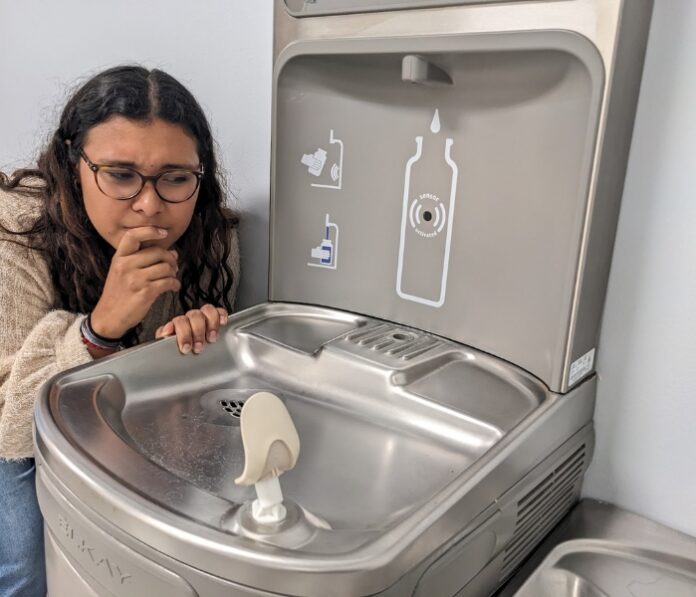The American Society of Microbiology (ASM) at the University of Dallas recently conducted a study of water quality from drinking sources both on and off campus. The study was aimed at testing for enterobacteria and fecal matter in the water. Students were encouraged to contribute water samples to test the cleanliness of their water.
The water tested included samples from drinking water in West Loop, Braniff water stations and Rathskeller water stations.
Anna Karki, senior biology major and president of ASM, said, “The way we test this is we put the water through a filter, and we collect that filter and we grow it in an EMB plate. This plate is selective against only enterobacteria – bacteria that will target your gastrointestinal tract, your stomach. So if there’s any other type of bacteria, any other type of pathogen in the water, it’s not going to show up in this test. We’re not concerned about the other ones. We’re just concerned about what we’re drinking and how it affects our digestive system.”
After 24 hours or so, the bacterial colonies can be examined.
“You can count the number of colonies, and the more colonies, the more serious the fetal contamination is,” said Karki. “This type of bacteria – because it’s in our intestines – comes from fecal matter, and the presence of them in the water is telling us that the water has been potentially contaminated with fecal matter.”
The tests found the presence of fecal matter in certain water sources, including small amounts in water sources on campus. The cleanest drinking water came from water dispensers in the Rathskeller. Most water sources passed the clean water standard, but the major finding was a surprising and concerning amount of contamination in water from West Loop that had been filtered in a refrigerator.
“The West Loop water is concerning,” said Karki. “West Loop needs to figure out what’s happening.”
The tests found that a random sample of toilet water had less fecal contamination than the sample from West Loop.
Nadia Guerrero, senior biology major, said, “I think one of the most surprising results we had is toilet water – you would expect for there to be lots of fecal contamination. However, we only saw a few colonies compared to the West Loop water. The constant flushing of the toilet doesn’t allow much bacteria to grow. Most of the time, a lot of the bacteria comes from aerosols – the flushing of previous particles – but the toilet water itself isn’t too contaminated. In terms of fecal contamination, it’s fairly cleaner than most other sources we saw.”
The tests also found that the most contaminated water source (although mild) on UD’s campus was the water dispenser in Braniff just outside the Cowan-Blakely Memorial library.
Most of the common gram negative enterobacterias detected in the water are mesophiles, meaning their optimal temperature for growth and replication is 37 degrees Celsius – the same temperature as the human body. Thus, enterobacteria find a perfect host in the human body.
According to Karki, enterobacteria, because it attacks the gastrointestinal system, can cause stomach aches, UTIs, diarrhea and vomiting and can leave the host vulnerable to other illnesses. Fortunately, there are DIY ways to drink clean water. One sure way to kill these bacteria is to boil the water and then refrigerate it.
“This way you are killing not only the bacteria like mesophiles, you can also kill the bacterias that survive in warmer temperatures,” said Karki. “So maybe the boiling didn’t kill them because they’re able to survive at that temperature, but if I put them in the fridge, I’m killing the bacterias that can survive in the cold and also in the hot, which means when I drink the water, there’s no bacteria that’s actually gonna harm me. And it tastes better.”
The club also stresses the importance of everyday cleanliness.
“It’s important to have proper hand hygiene, because anytime that you don’t wash your hands after using the restroom – that spreads really easily,” said Guerrero.
The source of the contamination is not exactly known.
“If the water is coming from a dirty pipe, while the water is flowing through the pipe, it could be carrying the bacteria in it, and that’s what we could be seeing,” said Karki. “So it may not just be the source of the water. It may be the dispenser or the pipe that it’s coming from that is not being cleaned.”
“I think at least cleaning the dispenser itself occasionally, or at least, once a week, would be helpful,” said Guerrero.
ASM hopes that their findings will spread awareness among the student body.
“People probably do not realize what they’re drinking,” said Karki. “And I think it’s important to most people that they know what they’re drinking. If there’s something harmful in it, they would like to know, because they’re under the assumption that it’s probably good or clean, just because they were told it was. [It’s important that] you know what you’re putting inside your body.”
“It’s really important to look at the water quality standards that at least the school has or the apartments may have. It’s really important to get educated, especially in case you do start experiencing any symptoms. If you do start experiencing symptoms, at least you can have a possible idea of what might be causing it,” said Guerrero.
The club will be hosting another water test today at 5:30 p.m. in the Haggerty Science Center, room 112. All are welcome to bring their own water samples to test and can be notified of the results after 24 hours.
